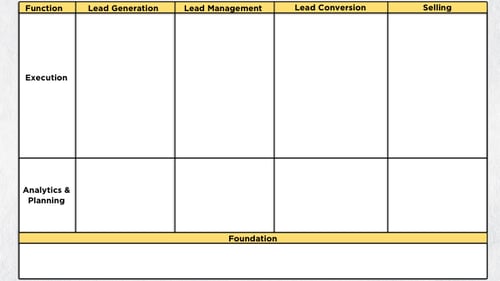 According to McKinsey, most companies achieve less than one-third of the impact they expected from recent digital investments.
According to McKinsey, most companies achieve less than one-third of the impact they expected from recent digital investments.
Just sit with that stat for a minute.
In a time when sales and marketing technology (aka the growth stack) underpin virtually everything that happens in a business, the results often disappoint.
And yet, the number of technology choices and the size of the spend continues to grow. For example:
- Sales Enablement budgets are expected to increase by 50% by 2027. ( Gartner)
- The Marketing Technology Ecosystem had just 120 names when it started in 2011. The most recent stats put that number at more than 11,038 technology alternatives (and growing). (ChiefMarTec)
These stats demonstrate the increasing impact of technology on demand generation and sales.
Yet, despite all these investments, users are not seeing the returns they expected.
What good is having more choices if companies don’t seem to be making the right choices? How can you ensure that you get the expected ROI from your investments in tech?
You Need a Technology Strategy
Make no mistake, technology will not be the reason an organization is successful—but increasingly, it will be a major reason it fails.
However, this does not mean that you must use technology wherever possible.
Quite the contrary. It means that you must utilize (or not utilize) technology with intent and purpose.
If you’re working hard on your sales and marketing strategies, it’s time to ask if your technology strategy is up to par with your demand generation strategy. If not, you need to get to work fixing it!
If you want to develop a tech strategy and build an effective growth stack, here are five tips:
1. Don’t Buy Technology, Hire it
At Lift, we never “buy” technology, we “hire” it. We view technology through the exact same lens that we use when hiring new people; both enable businesses to do more, improve what they’re already doing, and/or lower costs.
The most common mistake organizations make is never clearly identifying the problem(s) that need to be solved and how to solve it. Instead, they buy technology because they fall in love with the idea and what it can do, investing in tech like it’s a toy, rather than a tool.
To combat this mentality, create a job description for your next investment in technology and outline the role that it’s going to fill. This approach, commonly referred to as the “jobs to be done” theory, puts you into a different paradigm, overcoming all the sales hype being brought to bear by tech companies.
Look at it this way: building a high-value tech stack is a lot like putting together a high-performance team. Individual talents are certainly important, but the larger question is, “How does this fit with the team and raise the overall level?” After all, sometimes the “best” tool doesn’t actually create the best result for your needs.
2. The Operative Question Today: Is it a People, Process or Technology Problem/Opportunity
I’ve always been a fan of systems thinking, and I regularly advise executives to “build the genius into the system.” This approach led me to ask whether an organization was dealing with an issue related to people or processes. Over the last year, I’ve added technology to the mix.
Answering this question is imperative before you make any decision surrounding technology. Note that technology is an accelerator—and it doesn’t much care what it’s accelerating.
That means that you must have your processes in order before you invest in technology.
I’ve seen it time and time again. People buy technology due to promises made by a tech vendor during an aggressive sales and marketing effort or out of envy of the results someone else claims to have achieved.
The problem, however, is that the process hasn’t been refined and technology multiplies the existing garbage.
3. Manage the Needs of Today, But Don’t Forget to Plan for Tomorrow
Tech debt is a concept that originated within software development. It refers “to the implied cost of additional rework caused by choosing an easy solution instead of using a better approach that would take longer.”
While selecting the right technology solution has always been difficult, a new—and, in many ways, larger—challenge has emerged.
It’s no longer enough to merely select the tech that addresses your needs today. You must also consider future needs and determine how all of this will work together. When you stop to think about this issue, you quickly realize how complex and hairy it is.
This, if for no other reason, is why you must create a technology strategy. You simply cannot afford to make tech decisions on an item-by-item basis.
4. View Your Tech Stack as a Hub and Spoke System
As the image below shows, there are two parts to your tech stack. At the base is your foundation. Two core technologies make up the base of the growth stack: your CRM and marketing automation tool (MAP). When selecting the foundation, you must focus on what solution will best serve as the platform.

From there, you add the solutions that enable you to get key “jobs” done. We’ve structured our tech stack strategy behind the core elements of the customer acquisition process, broken into two segments: analytics and execution tools. We share this construct to illustrate one approach, feel free to organize yours in whatever way makes sense for you.
By the way, if this topic is of greater interest to you, don’t miss our blog about The Ideal Tech Stack for Mid-market Companies Serious About Growth.
5. Your Tech Stack is not Static: Review it at Regular Intervals
It’s smart to regularly review the performance of every member of your team. In these reviews, you share what’s working and what’s not. You track and share key metrics and objectives to assess how well someone is doing, reinforce strengths, and highlight areas to focus on for improvement. In some cases, you may even place someone on a performance improvement program (PIP).
You do all these things because you want your employees to be a good fit for your company and to perform at their best level.
The same approach applies to your technology. Ask yourself:
- Why don’t you take the same approach with the solutions in your tech stack?
- When was the last time you gave your CRM, MAP, and other tools a review?
- Does each piece of your stack have a clear objective with metrics to back it up?
If not, you’ve got work to do.
The rate of change in the technology space is wicked fast—and it’s getting faster. Without a strong discipline of reviewing, adding, and paring key components of your growth stack, you quickly lose the impact you’re seeking.
After all, a tool is only as good as the way it’s being used. Implementing some simple disciplines will enable you to leverage the power of technology to drive greater results into the future.

 Doug Davidoff
Doug Davidoff
